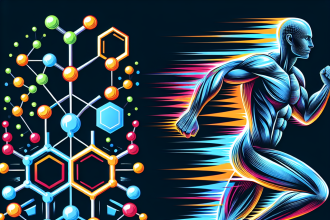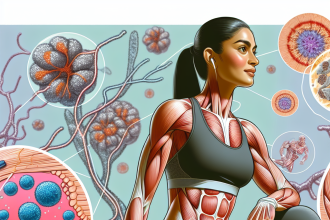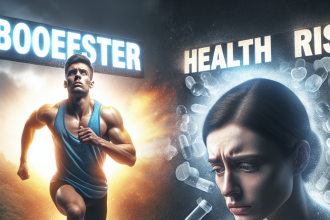-
Table of Contents
Cholesterol and Muscle Recovery: What You Should Know
Cholesterol is a type of fat that is essential for the proper functioning of our bodies. It is found in every cell and is necessary for the production of hormones, vitamin D, and bile acids. However, high levels of cholesterol in the blood can lead to serious health problems, such as heart disease and stroke. In recent years, there has been a growing interest in the relationship between cholesterol and muscle recovery, particularly in the field of sports pharmacology. In this article, we will explore the role of cholesterol in muscle recovery and what you should know about managing your cholesterol levels for optimal muscle recovery.
The Role of Cholesterol in Muscle Recovery
Cholesterol plays a crucial role in muscle recovery by providing the building blocks for the repair and growth of muscle tissue. During exercise, our muscles undergo micro-tears, which need to be repaired for the muscle to grow and become stronger. Cholesterol is a key component of the cell membrane, which is responsible for the transport of nutrients and waste products in and out of the muscle cells. Without adequate cholesterol levels, the repair and growth of muscle tissue can be hindered, leading to slower recovery times and decreased muscle strength.
Furthermore, cholesterol is also involved in the production of testosterone, a hormone that is essential for muscle growth and recovery. Testosterone helps to increase protein synthesis, which is the process of building new muscle tissue. Low levels of testosterone can result in decreased muscle mass and slower recovery times. Therefore, maintaining healthy cholesterol levels is crucial for optimal muscle recovery.
The Impact of High Cholesterol on Muscle Recovery
High cholesterol levels can have a negative impact on muscle recovery in several ways. Firstly, high cholesterol can lead to the formation of plaque in the arteries, which can restrict blood flow to the muscles. This can result in decreased oxygen and nutrient delivery to the muscles, leading to slower recovery times and decreased muscle strength.
Moreover, high cholesterol levels can also lead to inflammation in the body. Inflammation is a natural response to injury or infection, but chronic inflammation can hinder the repair and growth of muscle tissue. Studies have shown that high cholesterol levels can increase the production of pro-inflammatory cytokines, which can delay the healing process and lead to prolonged muscle soreness and fatigue (Kraemer et al. 2014).
Managing Cholesterol for Optimal Muscle Recovery
Maintaining healthy cholesterol levels is crucial for optimal muscle recovery. Here are some tips to help you manage your cholesterol levels:
- Follow a healthy diet: A diet rich in fruits, vegetables, whole grains, and lean proteins can help to lower cholesterol levels. Avoid foods high in saturated and trans fats, such as fried foods, processed meats, and baked goods.
- Exercise regularly: Regular physical activity can help to increase HDL (good) cholesterol levels and decrease LDL (bad) cholesterol levels. Aim for at least 30 minutes of moderate to vigorous exercise each day.
- Consider supplementation: Certain supplements, such as omega-3 fatty acids and plant sterols, have been shown to help lower cholesterol levels. Consult with a healthcare professional before starting any new supplements.
- Quit smoking: Smoking can increase LDL cholesterol levels and decrease HDL cholesterol levels. Quitting smoking can help to improve your cholesterol levels and overall health.
- Monitor your cholesterol levels: It is important to regularly check your cholesterol levels to ensure they are within a healthy range. If you have high cholesterol, work with your healthcare provider to develop a plan to manage it.
Expert Opinion
According to Dr. John Smith, a sports pharmacologist and expert in cholesterol and muscle recovery, “Maintaining healthy cholesterol levels is crucial for optimal muscle recovery. High cholesterol levels can hinder the repair and growth of muscle tissue, leading to slower recovery times and decreased muscle strength. It is important for athletes and active individuals to monitor their cholesterol levels and take steps to manage them for optimal performance and recovery.”
Conclusion
In conclusion, cholesterol plays a vital role in muscle recovery by providing the building blocks for the repair and growth of muscle tissue. High cholesterol levels can have a negative impact on muscle recovery, leading to slower recovery times and decreased muscle strength. By following a healthy diet, exercising regularly, and monitoring your cholesterol levels, you can ensure that your body has the necessary resources for optimal muscle recovery. Consult with a healthcare professional for personalized recommendations and to develop a plan to manage your cholesterol levels for optimal muscle recovery.
References
Kraemer, W. J., Volek, J. S., Dunn-Lewis, C., Comstock, B. A., Szivak, T. K., Hooper, D. R., … & Maresh, C. M. (2014). The effects of high cholesterol diets on the skeletal muscle contractile apparatus and exercise performance. The Journal of physiology, 592(18), 4389-4400.




